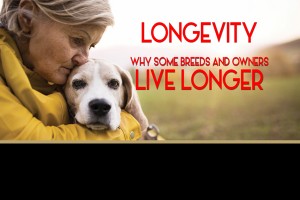Longevity – Why Some Breeds and Owners Live longer
Click here to read the complete article
120 – October, 2022
 By Dr. Carmen L. Battaglia
By Dr. Carmen L. Battaglia
Not everyone who wants to be healthy and live longer will actually be able to do it. Recent studies show that those who own a dog and follow a few lifestyle recommendations have the best chances. According to research findings, scientists are racing to collect information and document how. Five factors have been identified that make the difference, and–when taken together–they confirm that doing the right things contributes to a longer and healthier life for both owners and their dogs.
Information recently collected confirms that the “absolute limit” of the human lifespan is between 100 and 150 years. This was based on the research and analysis of 70,000 participants up to age 85 and their ability to fight disease, risk of heart conditions, and cognitive impairment. Scientists now believe the future looks promising and that the secret to longevity centers around the improvements made in medicine, the environment and technology. Each plays a role and contributes to lengthening an expected lifespan for both dogs and humans.
For example, it is now known that the aging process is influenced by a powerful “biological clock,” represented by the telomere/telomerase system which repeats sequences of non-coding DNA located at the terminal ends of chromosomes. These sequences play a major role in maintaining chromosome stability including the protection of genetic material from degradation during cell division. A number of studies show that chronic social isolation results in elevated levels of hormones that consequently affects the cellular mechanisms of aging, and shortens the telomere lengths (Boonekamp et al., 2017).
Many researchers have noted that the human body is made up of about 30 trillion cells constantly dying and being replaced by new cells. Within the cell body there are chromosomes and DNA with the codes written for humans. At the end of a DNA strand is a microscopic bundle of important material that gets snipped off when the cell divides. The average cell divides itself about 50 times before it loses its ability to replicate, and as more and more cells become ineffective and die, the signs of aging start to show in gray hair, weaker bones and vision loss. For example, Puhlmann et al. (2019), reported that telomere shortening is associated with the development of several of aging-associated diseases and structural changes in various regions of the brain. His results show that in order to extend the human life span, a combination of factors must be considered that link together lifestyle, diet and exercise:
Dog Ownership and Calories

Short URL: https://caninechronicle.com/?p=247501
Comments are closed











